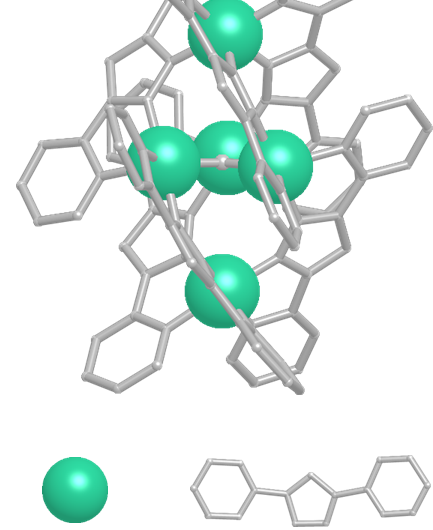February 24, 2016 report
Pentanuclear iron catalyst oxidizes water

(Phys.org)—Plants are able to convert sunlight into energy through photosynthesis. There is much interest in designing a system that mimics the photosynthetic process as an environmentally friendly way to produce energy from sunlight. One of the key reactions in photosynthesis is oxidizing water so that it breaks apart into its components, molecular oxygen (O2) and protons (H+). This reaction is catalyzed by photosystem II.
Research into a synthetic alternative to photosystem II has yielded catalysts that, while helpful, are not as practical for industrial use. The ideal catalyst would be cheap, robust, and reusable. Several researchers from various institutions in Japan have developed a pentanuclear iron catalyst that has many of these features. This catalyst has a turnover frequency of 1,900 s-1. Its five electrochemically active sites give it redox flexibility. Its adjacent active sites promote O-O bond formation and, thus, low activation energy. Their work appears in Nature.
When water is oxidized it produces O2, H+ and four electrons. In nature, including in photosystem II, whenever multiple electrons are involved in a redox process, it is better to have a catalyst that has multiple redox sites, or redox flexibility. In designing a pentanuclear iron catalyst, the authors thought it would have sufficient flexibility to promote electron exchange.
A catalyst serves to lower the energy in the rate determining step. It is thought that the rate determining step in the oxidation of water is the formation of O-O bond. Masaya Okamura, et al. therefore included in their design a way to promote O-O bond formation. Indeed, quantum chemical studies demonstrated that when two oxygens bind to two of the core iron atoms, a transition state forms that results in the evolution of oxygen gas.
Their pentanuclear complex is [FeII4FeIII(μ3-O)(μ-L)6]3+ where LH is 3,5-bis(2-pyridyl)pyrazole. Two iron atoms are coordinated to six atoms within the ligand structure while the three iron atoms within the core are coordinated to five atoms within the ligand stucture. Two of these core iron atoms are the active sites for the O-O bond formation.
Electrochemical studies confirmed that the catalyst undergoes five sequentially occurring reversible one-electron redox reactions in which FeII converts to FeIII. Addition of water showed evidence of oxygen evolution which was then quantified using controlled potential electrolysis in a two-compartment cell separated by an anion-exchange membrane. Gas chromatography measured the amount of O2. The catalyst demonstrated a Faradaic efficiency of 96% based on a four electron process and proved to be highly stable.
Electrochemical studies evidence a four-step one-electron oxidation cycle. Quantum chemical calculations of the system using density functional theory demonstrate a low energy barrier for the catalytic mechanism. Turnover frequency (TOF) was determined using the results of electrochemical measurements. The obtained TOF value was 1,900 s-1, which is 1,000 times greater than other reported iron-based catalysts.
This experiment demonstrates an effective design for a catalyst that promotes the oxidation of water. However, before this catalyst can be truly practical at a larger scale, additional studies will need to work out how to lower the large overpotential (greater than 0.5 V) and change the medium from acetonitrile/water to purely water.
More information: Masaya Okamura et al. A pentanuclear iron catalyst designed for water oxidation, Nature (2016). DOI: 10.1038/nature16529
Abstract
Although the oxidation of water is efficiently catalysed by the oxygen-evolving complex in photosystem II, it remains one of the main bottlenecks when aiming for synthetic chemical fuel production powered by sunlight or electricity. Consequently, the development of active and stable water oxidation catalysts is crucial, with heterogeneous systems considered more suitable for practical use and their homogeneous counterparts more suitable for targeted, molecular-level design guided by mechanistic understanding. Research into the mechanism of water oxidation has resulted in a range of synthetic molecular catalysts, yet there remains much interest in systems that use abundant, inexpensive and environmentally benign metals such as iron (the most abundant transition metal in the Earth's crust and found in natural and synthetic oxidation catalysts). Water oxidation catalysts based on mononuclear iron complexes have been explored, but they often deactivate rapidly and exhibit relatively low activities. Here we report a pentanuclear iron complex that efficiently and robustly catalyses water oxidation with a turnover frequency of 1,900 per second, which is about three orders of magnitude larger than that of other iron-based catalysts. Electrochemical analysis confirms the redox flexibility of the system, characterized by six different oxidation states between FeII5 and FeIII5; the FeIII5 state is active for oxidizing water. Quantum chemistry calculations indicate that the presence of adjacent active sites facilitates O–O bond formation with a reaction barrier of less than ten kilocalories per mole. Although the need for a high overpotential and the inability to operate in water-rich solutions limit the practicality of the present system, our findings clearly indicate that efficient water oxidation catalysts based on iron complexes can be created by ensuring that the system has redox flexibility and contains adjacent water-activation sites.
Journal information: Nature
© 2016 Phys.org



















